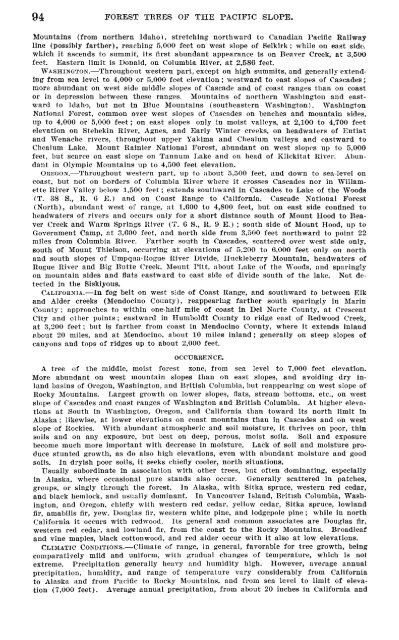De I. VNER VEW D Forest Trees of the Pacific Slope
De I. VNER VEW D Forest Trees of the Pacific Slope
De I. VNER VEW D Forest Trees of the Pacific Slope
You also want an ePaper? Increase the reach of your titles
YUMPU automatically turns print PDFs into web optimized ePapers that Google loves.
FOREST TREES OF THE PACIFIC SLOPE. 47<br />
Stands<br />
TOLERANcE.-<strong>De</strong>mands<br />
may remain<br />
large amount<br />
dense<br />
<strong>of</strong><br />
for<br />
light<br />
from<br />
throughout<br />
10<br />
life,<br />
to<br />
especially<br />
15 years,<br />
in older<br />
but<br />
age.<br />
trees above 20 feet in height<br />
after that<br />
require<br />
<strong>the</strong>y<br />
almost<br />
thin out<br />
unbroken<br />
rapidly;<br />
rarely closer than 30<br />
light.<br />
feet,<br />
<strong>Trees</strong><br />
and<br />
in<br />
<strong>the</strong><br />
mature<br />
crowns<br />
stands<br />
seldom<br />
are<br />
not endure intense light<br />
touch.<br />
and heat,<br />
In south,<br />
usually<br />
seedlings<br />
coming up<br />
do<br />
near logs, bowlders, in<br />
and<br />
shade<br />
brush,<br />
<strong>of</strong> old<br />
which<br />
trees,<br />
afford<br />
in openings<br />
slight protection;<br />
unprotected<br />
in north <strong>the</strong>y<br />
openings.<br />
grow in<br />
REPRODUCTION.-Frequent<br />
and abundant<br />
so that<br />
seeder.<br />
<strong>the</strong>re is<br />
Cones<br />
always are<br />
some<br />
locally<br />
seed<br />
produced<br />
in a forest;<br />
every<br />
good<br />
year,<br />
3 to 5 years. Germination<br />
seed years<br />
<strong>of</strong><br />
occur<br />
natural<br />
at intervals<br />
sowing, <strong>of</strong><br />
about<br />
from<br />
from 60 to 80 per cent.<br />
50 per<br />
Seed<br />
cent;<br />
is produced<br />
<strong>of</strong> artificial<br />
by trees<br />
planting,<br />
is scanty and <strong>of</strong> poor<br />
from<br />
quality<br />
20 to 25<br />
until<br />
years<br />
trees<br />
old,<br />
are<br />
but<br />
50<br />
generally<br />
over 1,000 cones; years<br />
average old.<br />
amount<br />
Large,<br />
<strong>of</strong><br />
thrifty<br />
seed, from<br />
trees<br />
1<br />
produce<br />
In dense stands, to<br />
but<br />
6<br />
in<br />
pounds.<br />
open forests<br />
Seed is<br />
it<br />
not<br />
is scattered<br />
carried fat<br />
in direction <strong>of</strong> prevailing<br />
from 500<br />
wind.<br />
to 700<br />
A mature<br />
feet from<br />
tree<br />
<strong>the</strong><br />
can<br />
tree<br />
an ordinary seed year.<br />
seed about<br />
Squirrels<br />
one-fourth<br />
and birds<br />
<strong>of</strong> an<br />
eat<br />
acre<br />
large<br />
in<br />
considerable numbers, numbers<br />
but can not<br />
<strong>of</strong><br />
be<br />
seeds<br />
depended<br />
and disseminate<br />
as washed down<br />
on<br />
steep<br />
for regular<br />
slopes reproduction.<br />
to stream beds<br />
Much<br />
and<br />
seed<br />
<strong>of</strong>ten occurs. Well<br />
depressions,<br />
drained, fresh<br />
where<br />
soils,<br />
good<br />
and<br />
reproduction<br />
a moderate daily<br />
necessary<br />
range<br />
for<br />
<strong>of</strong><br />
germination.<br />
temperature are<br />
Jeffrey Pinie.<br />
Piets jeffreyi " Oreg. Coin."<br />
DISTINGUISIIING CIHARACTERISTICS.<br />
Jeffrey pine is scarcely less magnificent in size than its associate <strong>the</strong> western<br />
yellow pine. Some specialists consider it a variety <strong>of</strong> Pinus ponderosa, w hich<br />
it resembles so closely in its habits and soil and climatic requirements that<br />
from <strong>the</strong> forester's lsoiit <strong>of</strong> view <strong>the</strong>re appears to be no practical reason for<br />
distinguishing <strong>the</strong> two. <strong>De</strong>ndrologically,<br />
however, <strong>the</strong> typical form <strong>of</strong><br />
Jeffrey pine (discovered in nor<strong>the</strong>rn California in 1850 by John Jeffreys) dif<br />
fers in many respects from western yellow pine. It is a large-bodied, straight<br />
tree, with a long, narrow crown, <strong>the</strong> branches <strong>of</strong> which are much less stout<br />
and angled than those <strong>of</strong> its relative. Its foliage is heavier, more dense, and<br />
a distinctly dark blue-green. As a rule, <strong>the</strong> dark red-brown bark is deeply<br />
fnrroxed, and <strong>the</strong> ridges, <strong>of</strong>ten narrowv, are irregularly connected with one<br />
nno<strong>the</strong>r. On very old trees <strong>the</strong> bark is deeply broken into long, wide plates <strong>of</strong> a<br />
bright red-brown color. The leaves (fig. 14, a), 5 to 91 inches long, occur in<br />
bundles <strong>of</strong> 3 and persist for from 5 to S and sometimes 9 years. In conse-<br />
quence, <strong>the</strong> foliage appears dense. The tvigs <strong>of</strong> a year's growth are con-<br />
siderably thicker than those <strong>of</strong> <strong>the</strong> western yellow pine, and distinctly purple<br />
when young; <strong>the</strong>y exhale, when cut or bruised, a fragramt, violet-like odor.<br />
The cones (fig. 14), purple at maturity, are a light russet-brovn after shedding<br />
<strong>the</strong>ir seeds, and are from 5k to 114 iiicbes long. The seeds (fig. 14, 0), larger<br />
than those <strong>of</strong> <strong>the</strong> western yellow pimie, are similarly nottled. Seed leaves, 7<br />
to 10-sometimes 11. Wood, light straw color and ra<strong>the</strong>r<br />
lar wide in commercial grained;<br />
value siiai-<br />
to w <strong>the</strong> vestern<br />
LONGEVITY.-Long-lived,<br />
yellow pine.<br />
reaching an age <strong>of</strong> from 300 to 410<br />
age<br />
years.<br />
determinations<br />
Fur<strong>the</strong>r<br />
are required.<br />
RANGE.<br />
Mountains <strong>of</strong> sou<strong>the</strong>rn Oregon and southward to nor<strong>the</strong>rn Lower California.<br />
OREGOo.-Found at only two stations-one about 30 miles south <strong>of</strong> Roseburg, In<br />
Douglas County, and <strong>the</strong> o<strong>the</strong>r near Waldo, in <strong>the</strong> Siskiyou Mountains.<br />
CALIFOaNIA.-Sources <strong>of</strong> Pitt River and (high levels) on Scott Mountains (near Mount<br />
Shasta), west <strong>of</strong> and on east slope Mount Eddy down to level and near Sisson; reported<br />
in Trinity Mountains at elevations above 3,5oo feet, and on Snow Mountain (Lake<br />
County). East side <strong>of</strong> Sierras, in central and sou<strong>the</strong>rn parts, between about 9,000 and

















